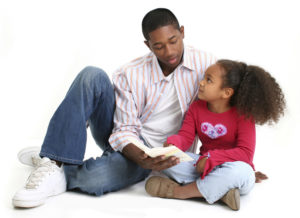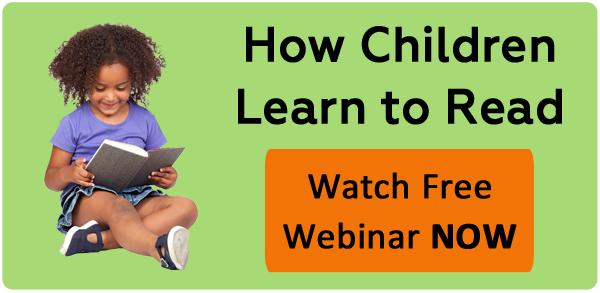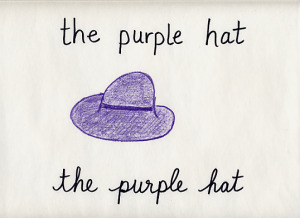
“It’s just a miracle!” parents exclaim. “Our son is five years old and he’s reading.”
When children begin to read, it does seem miraculous.
Remember when your child began to talk? It seemed as if one day she couldn’t say a word and the next day she could, then you could never get her to stop.
It is the same with reading. It seems to appear out of nowhere, but in actuality the very first step to reading begins the moment we hear our first word.
At its simplest, reading is just understanding the written thoughts of another human being.
All that understanding begins with the first word we hear. Words have meaning and we read for meaning and understanding.
Learning to read is a process that begins a long time before your child enters kindergarten.
Because reading and writing are based upon spoken language, you want to make sure your child has a language rich environment from birth.
You can create a language rich environment by doing the following:
- Reading out loud to your child
- Singing to and with your children
- Speaking clearly and directly to your child so he can see your face to see how words are formed o helping your child become aware that words are made up of individual sounds. This skill is called phonemic awareness.
- Helping your child know that letters represent sounds, a skill that is called letter/sound recognition.
After your child acquires the two basic skills for reading, phonemic awareness and letter/sound recognition, you will see a “burst” into reading, much like the “burst” into speech.
There will be that magical day when your child discovers he can read.
He will begin by reading one word at a time. You’ll hear exclamations from the backseat of the car, “Dad! Did you know that red sign says, “STOP”?”
At this first level of reading you can offer vocabulary cards that have a picture and just one word, for example, a picture of an alligator and the word beneath it. These cards will give a visual clue to your child, and help them build word recognition. These types of cards are available in the toy section of most stores. You can also make your own cards with your child using 3×5 index cards and using magazine cut outs, stickers, or drawings for the pictures.
At the first level the child may “sound” out the words, but through repetition, the eye and brain begin to remember a word at a time, so that the child can see the word “alligator” and know it and say it without consciously having to sound it out. Through repetition, the child develops a visual memory of a word, which makes reading faster and more enjoyable.
The second level is to read two or three words at a time. Many children when they get to this point want to go straight to books that have too much text for their level of eye control and visual memory.
Beginner readers, since they “know” they can read, want to go straight books they see older readers reading, such as the Harry Potter books. They are heartbroken when they realize they can’t read it.
At this moment, they are in danger of becoming discouraged.
You must be there for them by continuing to read out loud to them and helping them make books that will help them develop their eye control and visual memory.
Writing and making little books will help develop word recognition, along with left-to-right hand and eye coordination. With your new reader, make little books that have lots of visual clues.
The Hat Book is one of my students’ favorite first books.
We draw hats in ten different colors and write the words in print and cursive. We make a booklet using half sheets of copy paper. The pages read: the black hat, the red hat, the pink hat, the brown hat, the gray hat, the purple hat, the orange hat, the white hat, the yellow hat, the blue hat, the green hat. Using the names of colors we get a lot of phonogram practice (sounds made with two or more letters). We have a visual clue of what the words should say, plus we’ve written it ourselves.
Make lots of little books that your children can create and read. Use bugs, cats, dogs, mugs, bears, alligators, hippopotami, caterpillars…the list goes on and on.
The third level is to create books with five or more words in a complete sentence. You might do a hat book with sentences like these: The black hat is small. The red hat is large. The yellow hat is just right.
After your child develops fluency with one sentence per page, begin to make books with two sentences per page, one underneath the other.
The black hat is small.
It does not fit me.
At this point, your child is ready to start into books that have two or three lines of print per page. Some children may get to this point in a few weeks. For others it may be many months. The important thing is that you keep it fun and successful.
Encourage story writing and book making.
Writing, be it creative or copying, is more important to the development of reading skills than having your child read out loud to you.
Reading out loud is a dramatic, expressive skill that requires memory and emotional interpretation. Reading for understanding is a receptive language skill, much like understanding what someone is saying to you.
Your child needs to develop receptive reading skills and expressive reading skills before you can expect her to use both skills at the same time to read out loud.
To maximize your child’s efforts in reading, have him write instead of read out loud to you.
Writing reinforces the receptive skills of reading, as well as the expressive skill of writing. Singing, memorizing poetry and Bible verses will help develop your child’s expressive reading skills. At some point he will take these two different skills and use them to be a fluent and expressive reader.
Continue to nourish a love of language in your children by reading out loud every day to your children, through elementary school. At some point, they will volunteer to read the chapter out loud. Serial reading or chapter book reading ideas can be suggested by your public or school librarian. Jim Trelease’s book, A Read Aloud Handbook, is also a wonderful resource.
The road to reading is a long one, but when you are aware of the developmental needs of your child, it should be a smooth ride with very few bumps.



Very informative with simple implementation steps. Thanks for the article.
Dear Maren,
Your articles on reading are outstanding and absolutely right on target! As a life-long educator of young children and Montessori teacher, I have looked for high quality series on reading such as yours and other early childhood issues for years. Your accurate, thoughtful educational series on literacy are refreshing and should be read and implemented by all parents and educators of young children. I am so glad to have found your website KIDS TALK . Keep up the good work!
Kindest regards,
Hannelore Gottschalk
Hannalore,
You are so welcomed!
This Children’s Literacy Series contains ten articles.
More to come!
All the best,
Maren
Excellent information, explained in steps one, two, three! Early writing is an important step in children’s learning as it should but be not frustrating to the child!
Celine,
Good to hear from you. Frustration does keep us from learning!